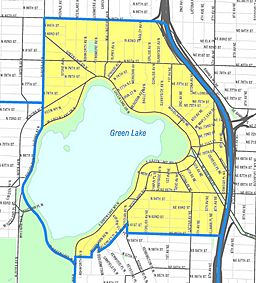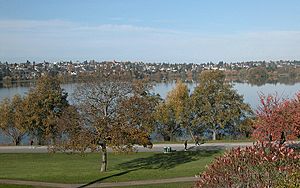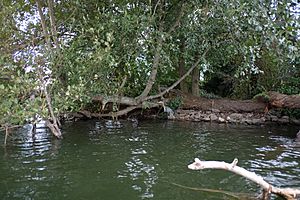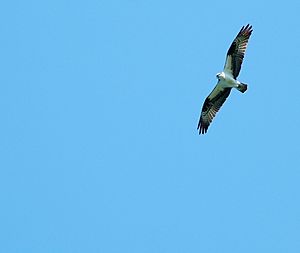Green Lake (Seattle) facts for kids
Quick facts for kids Green Lake |
|
|---|---|
| dxʷƛ̕əš | |

Looking southwest toward Woodland Park
|
|

Map of Green Lake
|
|
| Location | Seattle, Washington |
| Coordinates | 47°40′41″N 122°20′13″W / 47.678°N 122.337°W |
| Basin countries | United States |
| Surface area | 259 acres (1.05 km2) |
| Average depth | 13 ft (4.0 m) |
| Max. depth | 30 ft (9 m) |
| Shore length1 | 2.8 mi (4.5 km) |
| Surface elevation | 160 ft (49 m) |
| 1 Shore length is not a well-defined measure. | |
Green Lake (Lushootseed: dxʷƛ̕əš) is a freshwater lake in north central Seattle, Washington. It is located within Green Lake Park. The park is surrounded by several neighborhoods. These include Green Lake, Wallingford, Phinney Ridge, and Woodland Park.
Green Lake is a glacial lake. It was formed about 50,000 years ago. A giant ice sheet called the Vashon glacier dug out its basin. This same glacier also created other nearby lakes like Lake Washington and Lake Union.
Contents
History of Green Lake
The native language of Seattle, Lushootseed, calls Green Lake dxʷƛ̕əš. We don't know why it has this name. David Phillips gave it the English name "Lake Green" in 1855. He noticed that the lake often had green algae blooms, even back then.
Green Lake covers about 259 acres (1.05 km2). Its average depth is 13 feet (4.0 m), and it can be as deep as 30 feet (9.1 m). The lake has been dug deeper over time to keep its depth.
The lake does not have rivers flowing into or out of it anymore. It used to drain into Lake Washington through Ravenna Creek. But in 1911, the lake's water level was lowered by 7 feet (2.1 m). This was done to create more parkland. The creek then dried up between Green Lake and Cowen Park. Today, Ravenna Boulevard is built over the old creek bed. Now, the lake gets its water from rainfall, storm runoff, and Seattle's city water supply.
Early Days and Development
The land around Green Lake was first settled by pioneers. One of the first was Erhart Sarfried, known as "Green Lake John." He sold parts of his land in 1888. People then started building things around the lake. W.D. Wood tried to build an "amusement park" on the west side. It ended up being mostly a large lawn for picnics. On the east side, A.L. Parker cut down trees and built a sawmill.
Edward C. Kilbourne built the first trolley line to connect the area to the city. This route is now Green Lake Way North. More trolley lines were added, and by 1910, you could ride a trolley all the way around the lake.
Mystery Spikes in the Lake
In 2008, metal spikes up to 3 feet (0.91 m) long were found at the bottom of the lake. One person was slightly injured after stepping on them. The Seattle Parks Department later explained that the spikes were from an old project. In 1984, they had tried to control an invasive plant called Eurasian water milfoil. They used black plastic sheets held down by these spikes. The spikes originally had curved tips to prevent injuries, but these tips had rusted away. Divers were hired to remove the remaining spikes. The city had also tried using fish to eat the weeds, but hadn't done much serious work in 15 years.
Green Lake Park: A Place for Fun
After 1903, the Green Lake area became part of Seattle's big Olmsted Plan. This plan aimed to create a network of connected green spaces across the city. The park's design still shows this original vision.
Paths and Activities
A paved path 2.8 mi (4.5 km) long goes around Green Lake. It's great for walking and running. During the COVID-19 pandemic, bikes and other wheeled vehicles were not allowed on this path. This was because many people were walking, and new bike lanes were being built. This rule is still in place as a "long-term temporary" restriction.
The path is very popular for exercise and relaxing. It can get quite busy! There is also a longer, unpaved path 3.2 mi (5.1 km) around the edge of the park. The park is a popular spot for many activities. These include qigong classes, roller hockey, soccer, baseball, golf, and lawn bowls. There's even a monthly midnight bicycle race.
Park Buildings and Features
The bathhouse was built in 1927. It was next to an outdoor swimming area with concrete steps into the water. A lifeguard station was added in 1930 after some drownings. Today, the bathhouse is home to the Seattle Public Theater.
Across the lake, in the northeast part of the park, is Green Lake's first community center. It was built in 1929. It has conference rooms, a gym, and a stage. Another stepped swimming area was built nearby. Tennis courts were added in 1945. In 1955, a large swimming pool called Evans Pool was added. It was named after brothers Ben and Lou Evans, who served Seattle parks for a long time.
The children's wading pool was built as a Works Progress Administration project. This project also created the drainage ditch and an arched stone bridge over it. The wading pool is open in the summer with staff from the Seattle Parks department.
South of the bathhouse, there is a lawn and a fishing pier. Since 1984, this area has hosted an annual floating lantern memorial. It honors the victims of the atomic bombings of Hiroshima and Nagasaki and all other victims of war.
Prospect Point is a piece of land that sticks out into the lake. It protects a small area of water from strong winds. This spot used to be popular for model boats, but model boating is no longer allowed on the lake.
The Aqua Theater
The Green Lake Aqua Theater was built in 1950 for the first Seafair festival. It hosted "swimusicals" called the Aqua Follies. These shows combined aqua ballet, stage dancing, and comedy. The theater had a round stage and a floating orchestra pit. It surrounded a part of the lake with high diving platforms. The grandstand could hold over 5,000 people.
The Aqua Follies ran during Seafair until 1965. Other plays and musicals were also performed there. In 1962, during the Century 21 Exposition (World's Fair), the Aqua Theater hosted a jazz festival and famous performers like Bob Hope. After the World's Fair, summer shows became less popular. This was often blamed on Seattle's unpredictable weather.
The Aqua Theater was mostly left unused. A 1969 concert by the Grateful Dead showed that the grandstand was falling apart and unsafe. Starting in 1970, the theater was taken down. What was once stage right is now a walking pier. Stage left provides a dock and storage for crew boats. Some parts of the grandstand still remain.
Connecting to Woodland Park
The southwest part of Green Lake Park connects to Woodland Park. Much of this land was created using dirt from digging the route for Aurora Avenue. The lake used to reach what is now N. 54th Street.
Boating and Water Sports
In the summer, Green Lake is popular for swimming and boating. Motorized boats have been banned since at least 1968. However, the lake used to host hydroplane races from 1929 to 1984. Today, you can see many types of motor-less boats. These include sailboards, pedal boats, rowboats, skiffs, and canoes.
The Milk Carton Derby is held annually on the lake. It's one of the opening events of Seafair. While some old boat launches still exist, all new launches have been removed. All boats must now be carried by hand to the water.
Green Lake Small Craft Center
The Green Lake Small Craft Center is a Seattle Parks facility. It is located at the south end of the lake. It is home to both Green Lake Crew and the Seattle Canoe and Kayak Club. In 2006, Green Lake hosted the USRowing Masters National Championship Regatta. About 2,000 competitors, aged 23 to 86, took part.
Green Lake Library
To the east of the lake, across from the park, is the Green Lake Library. It was built in 1910 with money from Andrew Carnegie.
Duck Island: A Wildlife Spot
Inside the lake is an artificial island called Duck Island. It was originally named Swan Island. The Works Progress Administration built it in 1936 using dumped gravel. The island was meant to be a wildlife sanctuary. It later housed some swans given to the city by Vancouver, British Columbia. The park board named it Waldo's Wildlife Sanctuary, after Waldo J Dahl, who cared for the swans.
The swans did not have a good place to breed on the island. Later attempts to breed swans also failed. In 1956, the state game commission made the island a reserve, meaning people were not allowed on it. This rule ended in 1983. The island is not known for unique wildlife, but it is part of a buffer zone for bald eagles. The parks department still considers the island off-limits to people for safety reasons.
Green Lake Crew: Rowing and Paddling
The Green Lake Small Craft Center is a Seattle Parks facility. It is the training ground for Green Lake Crew. This team has a history of successful rowing at the national level.
The Green Lake Small Craft Center also hosts the Seattle Canoe and Kayak Club. This club focuses on Olympic-style sprint paddling and also competes nationally.
Animal and Plant Life at Green Lake
Green Lake is a great place to see wildlife. Many different animals live here or visit. You might see toads, ducks, cormorants, loons, herons, geese, turtles, raccoons, rats, squirrels, bats, hawks, eagles, and osprey.
Abandoned Pets and Their Impact
Green Lake has sometimes been a place where people abandon unwanted house pets. This led to a large population of feral rabbits. These rabbits caused problems by digging tunnels under streets and into the Woodland Park Zoo. Volunteers tried to adopt or remove the rabbits, but they multiplied too quickly. In 2005, the city, zoo, and Rabbit Sanctuary worked together to remove all the rabbits. They also started a program to teach people not to abandon pets.
Abandoning pets in or around Green Lake has led to other non-native species needing to be removed. Most often, these are ordinary goldfish. But sometimes, more unusual animals like sturgeon and even caiman have been found.
Water Quality and Management
Recently, a program has been put in place to reduce the number of ducks and geese. Their droppings add phosphorus to the lake. This causes too much algae and milfoil to grow. In 2003, the lake was treated with aluminum sulfate to trap the phosphorus. A special boat is used to cut the milfoil. The birds also leave pathogens in the lake, which can cause Swimmer's itch. This shows how hard it is to keep the water clean in a lake that doesn't have much water flowing in or out.
Fish Species
Many kinds of fish live in Green Lake. Trout, mostly rainbow trout, are put into the lake for people to fish. There is a large population of common carp. You can see them laying eggs in the shallow water in spring. Tiger muskellunge were added to help control the carp population. Carp are seen as an invasive species and can make the lake's water quality worse. The lake also has largemouth bass, yellow perch, bluegill, yellow bullhead, channel catfish, and small numbers of other unexpected species.
Trees and Plants
In the spring, Green Lake Park is beautiful with pink and white cherry trees blooming. These trees were planted along the west side of the lake in 1931 and 1932. They were a gift from the Japanese Association of North America.
Common Animal Species List
The park is home to many kinds of birds and mammals. It also has some reptiles and amphibians. Some notable species include feral rabbits, Barred Owls, and Red Eared Sliders (released turtles).
- Common Birds: American Crow, American Goldfinch, American Robin, Anna's Hummingbird, Bald Eagle, Barn Owl, Barred Owl, Bewick's Wren, Black-Capped Chickadee, Bushtit, European Starling, House Finch, Hairy/Downy Woodpeckers, Northern Flicker, Oregon Junco, Red-winged Blackbird, Eurasian Rock Dove, Spotted Towhee, Steller's Jay, various Gull species, various Sparrow species (including Song Sparrow), and various Swallow species.
- Common Waterfowl: Buffleheads, Common Merganser, Gadwalls, Mallards, North American Coots, North American Widgeons, and Pied Billed Grebes.
- Mammals: Nutria, feral rabbits, Norway Rats, Gray Squirrel, Mountain Beaver, and American Beaver.
- Reptiles and Amphibians: Red Eared Sliders, Spring Peepers, and Garter Snakes.
Images for kids










